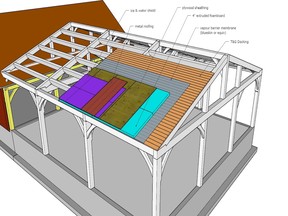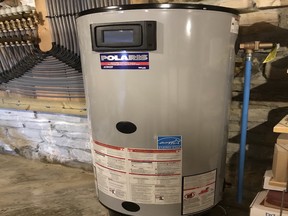
Reviews and recommendations are unbiased and products are independently selected. Postmedia may earn an affiliate commission from purchases made through links on this page.
Q Is it a good plan to use foam to insulate on top of the rafters of the timber frame workshop I’m building? My thoughts are to use four-inch-thick (R20) foam board installed as shown in the sketch I sent you. I realize that R20 is a bit light for a roof in Canada, but I plan to use ice and water shield as a vapour barrier on the warm side of the installation. After all, it’s just a shop.
A Your plan looks good, and it’s essentially what I’ve done on a couple of projects I’ve built. The thing to keep in mind is that R20 on the roof won’t be enough to completely stop melting of roof snow and some ice dam formation when conditions are ripe. This means snow on the roof, with temperatures four or five degrees below freezing, plus normal room temps in your shop. Even with more insulation in the roof (say, R40), you’ll still have something of this icing effect, as I know from experience.
Sign up to receive daily headline news from Ottawa Citizen, a division of Postmedia Network Inc.
Thanks for signing up!
A welcome email is on its way. If you don't see it, please check your junk folder.
The next issue of Ottawa Citizen Headline News will soon be in your inbox.
Whether or not this icing will be significant remains to be seen. But with ice and water shield directly under the roofing, even if backed up water does form, it won’t leak into your building.
———

Electric water heater for space heating?
Q Can an electric, tank-style water heater work for space heating with hot water in a radiant infloor installation? My wife and I are building a retirement home in northern Ontario and we’re sorting out our options. There’s no natural gas available in the area, so we’re looking at propane or electricity.
A: There are several things to consider, but yes, a heavy-duty electric water heater or propane water heater can be used to deliver hot water to infloor systems and radiators. I’ve seen both work well. That said, propane offers an advantage you might not have considered. When the grid goes down you’ll need a very large generator to provide enough electrical power to keep you warm. Propane, on the other hand, offers you a large reserve of energy right on your property in the tank. It only takes a small generator to provide the electricity to run a propane system because the power is only needed to operate the control system and the circulation pumps. That said, you might consider having both propane and electric systems for heating, and the reason is a complete surprise to most people.
Assuming a price of 15 cents per kilowatt-hour for electricity (that’s what I pay in northern Ontario, all-in), any propane price higher than 85 cents a litre is more expensive per unit of heat delivered to your home than electricity when run through a propane boiler with an 85 per cent efficiency rating. I know many people who pay more than 85 cents for propane and don’t realize that it’s costing them more to heat than if electricity was used in baseboard heaters or a water heater. Given the relatively low cost of an electric water heater, you might consider having both propane and electricity as options for heating. Propane prices often spike up higher than 85 cents per litre, while electricity costs are much more stable. Having a dual system allows you to use the least expensive option at any given time, plus it gives you more reliability. If one system breaks you’ve got the other until repairs can be made.
Another thing to consider is an electric heat pump instead of a tank-style water heater. Models are available that harvest heat from cold winter air, and concentrate that heat in water for heating. Heat pumps generally deliver two to three times as much heat energy as they consume in electricity, and this corresponds to an equivalent propane price of just 40 cents per litre or less.
Steve Maxwell thinks a lot about heating systems. Visit him online at BaileyLineRoad.com for articles, videos and inspiration for Canadian homeowners.


